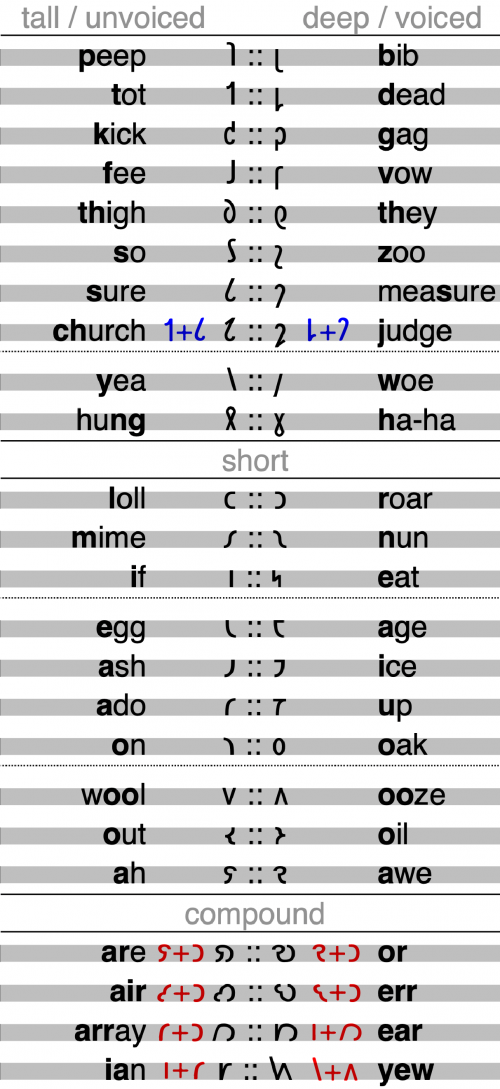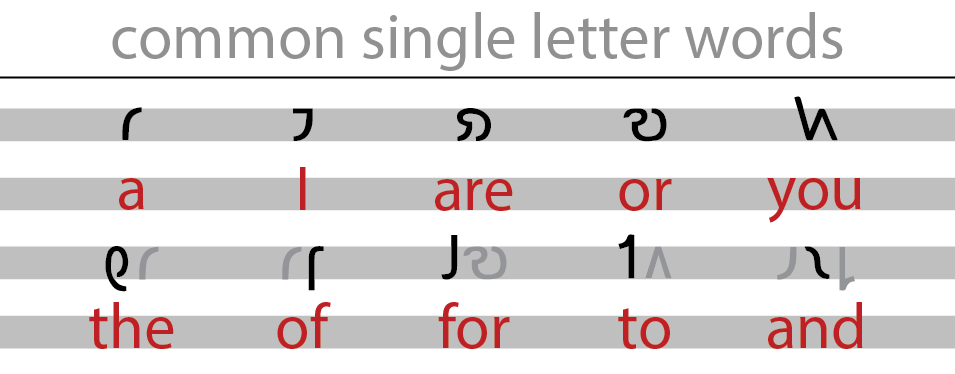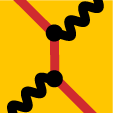John F. Lindner
Shavian Alphabet

I still retain the personal, episodic memory of my first encounter with the spelling of people. I was learning to read, and I got cat, mat, pat. I got lot, pot, dot. But I did not get people. I was shocked. Why the o, and why the le instead of el? And shouldn’t Wednesday be something like Wensday or even Wenzday? And why was w in two? I had discovered the Latin alphabet’s historical irregularity (which may have contributed to my later focus on the regularity of natural laws studied by physics).
Shavian is a better English alphabet created principally by Kingsley Read in the mid twentieth century for a competition funded by the will of Nobel-Prize-winning Irish playwright George Bernard Shaw. In contrast to Latin’s 2 × 26 = 52 letters, Shavian’s 48 letters uniquely represent 48 English sounds. The letters can be drawn with single gestures and are rotations or reflections or compounds of companion letters. Often the shapes of the letters suggest their pronunciations; for example, most unvoiced letters are tall, and their voiced counterparts are deep. Different letter pronunciations can accommodate different English accents with the same spelling. Shavian has no capital letters, but a leading center dot denotes proper names.
In ·𐑖𐑩𐑝𐑾𐑯, people is spelt 𐑐𐑰𐑐𐑩𐑤, with letters peep 𐑐, eat 𐑰, ado 𐑩, and loll 𐑤, and without the extraneous o and the “reversed” (French?) le. Judge and judge are both 𐑡𐑳𐑡, starting and ending with the same letter judge 𐑡 surrounding the letter up 𐑳. Night and night are 𐑯𐑲𐑑, with letters nun 𐑯, ice 𐑲, and tot 𐑑, without the unpronounced gh, and without needing to dot the i and cross the t when handwriting! Common short words are abbreviated with single letters, so and becomes 𐑯 instead of 𐑨𐑯𐑛, and the becomes 𐑞 instead of 𐑞𐑩, and I find this works well in practice.
Due to the Great Vowel Shift, the Latin letters combination ea sounds differently in bread, break, beat, bear which ·𐑖𐑩𐑝𐑾𐑯 renders uniquely as 𐑚𐑮𐑧𐑛, 𐑚𐑮𐑱𐑒, 𐑚𐑰𐑑, 𐑚𐑺. Conversely, queer, weir, ear, fear, fierce are consistently rendered 𐑒𐑢𐑽, 𐑢𐑽, 𐑽, 𐑓𐑽, 𐑓𐑽𐑕. Ripple, repel, repeal are neatly organized as 𐑮𐑦𐑐𐑩𐑤, 𐑮𐑦𐑐𐑧𐑤, 𐑮𐑦𐑐𐑰𐑤. Gouged and chipped become 𐑜𐑬𐑡𐑛 and 𐑗𐑦𐑐𐑑, where dead 𐑛 is the voiced version of tot 𐑑.
Many ·𐑖𐑩𐑝𐑾𐑯 resources exist online. Recently, I’ve enjoyed reading ·𐑖𐑻𐑤𐑪𐑒 ·𐑣𐑴𐑥𐑟 stories, and I just finished 𐑕𐑑𐑮𐑱𐑯𐑡 𐑒𐑱𐑕 𐑝 ·𐑛𐑼. ·𐑡𐑧𐑒𐑩𐑤 𐑯 ·𐑥𐑼. ·𐑣𐑲𐑛. Sensible spelling is so satisfying, and I’m learning about the sounds of words, including subtleties not represented by the history-battered Latin alphabet, as well as discovering that I have been over-regularizing my pronunciations to make the Latin alphabet work better.
𐑑𐑩𐑛𐑱, ·𐑖𐑱𐑝𐑾𐑯 𐑦𐑟 𐑥𐑱𐑯𐑤𐑦 𐑝 𐑦𐑯𐑑𐑼𐑩𐑕𐑑 𐑑 𐑣𐑪𐑚𐑦𐑦𐑕𐑑𐑕. 𐑞 𐑦𐑯𐑻𐑖𐑩 𐑩𐑜𐑧𐑯𐑕𐑑 𐑗𐑱𐑯𐑡𐑦𐑙 𐑞 ·𐑦𐑙𐑜𐑤𐑦𐑖 𐑨𐑤𐑓𐑩𐑚𐑧𐑑 𐑦𐑟 𐑣𐑿𐑡. 𐑚𐑳𐑑 𐑦𐑓 ·𐑦𐑙𐑜𐑤𐑦𐑖-𐑕𐑐𐑰𐑒𐑦𐑙 𐑣𐑿𐑥𐑩𐑯𐑟 𐑢𐑳𐑯 𐑛𐑱 𐑥𐑱𐑒 𐑩 𐑯𐑵 𐑕𐑑𐑸𐑑 𐑪𐑯 𐑩𐑯𐑳𐑞𐑼 𐑢𐑻𐑤𐑛, 𐑐𐑼𐑣𐑨𐑐𐑕 𐑩 𐑕𐑦𐑑𐑦-𐑕𐑑𐑱𐑑 𐑪𐑯 ·𐑥𐑸𐑟 𐑹 ·𐑑𐑲𐑑𐑩𐑯 𐑹 𐑩 𐑡𐑧𐑯𐑼𐑱𐑖𐑩𐑯𐑩𐑤 𐑦𐑯𐑑𐑼𐑕𐑑𐑧𐑤𐑼 𐑕𐑐𐑱𐑕𐑖𐑦𐑐, 𐑞𐑱 𐑥𐑲𐑑 𐑗𐑵𐑟 𐑑 𐑳𐑐𐑜𐑮𐑱𐑛 𐑞𐑺 𐑨𐑤𐑓𐑩𐑚𐑧𐑑. 𐑣𐑬𐑧𐑝𐑼, 𐑞𐑺 𐑮𐑦𐑥𐑱𐑯𐑟 𐑞 𐑕𐑽𐑾𐑕 𐑐𐑮𐑪𐑚𐑤𐑩𐑥 𐑝 ·𐑦𐑙𐑜𐑤𐑦𐑖 𐑜𐑮𐑨𐑥𐑼 … .
Shavian Primer



Shaved Texts

Using public-domain texts and free online tools, below are novels I shaved (transliterated from the Latin alphabet to the Shavian alphabet).
A Christmas Carol, by Charles Dickens, in Shavian (2024)
Last updated 2024 December 4
(2 MB, 65 pages)
This was the first novel I shaved. I resolved heteronyms, used center dots before first and last proper names, angular brackets <…> for quotations, omitted apostrophes except for some word fragments, and underlined words that Dickens’ italicized.
Pride and Prejudice, by Jane Austen, in Shavian (2024)
Last updated 2024 December 4
(8.7 MB, 255 pages)
This was the first full-length novel I shaved. Center dots appear before first and last proper names, underlines emphasize words, straight quote marks delineate quotations, Georgie typeface controls punctuation and spacing, and Gill Sans typeface for numbers distinguishes tot 𐑑 from one and oak 𐑴 from zero.
Great Expectations, by Charles Dickens, in Shavian (2025)
Last updated 2025 January 8
(10.8 MB, 395 pages)
This was the second full-length novel I shaved. I used the LaTeX within Apple‘s Pages to move underlines completely underneath the words they emphasize and also kern the pair 𐑚𐑿. Apostrophes, quotes, and commas are essentially the same simple mark.
A Study in Scarlet, by A. Conan Doyle, in Shavian (2025)
Last updated 2025 January 16
(2.6 MB, 92 pages)
A French sentence and a Latin sentence are both rendered in the Latin alphabet.
Jane Eyre: An Autobiography, by Charlotte Brontë, in Shavian (2025)
Last updated 2025 February 25
(11 MB, 401 pages)
French (and other non-English) phrases are rendered in the Latin alphabet, but the abbreviations etc. and e.g. are rendered in Shavian. I also added translations in red inside square brackets; readers who know the language can skip the red Shavian translations and read the Latin original, and readers who don’t know the language can skip the Latin original and read the red Shavian.


